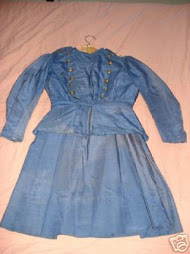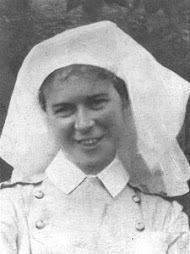A very happy new year to the readers of Finding the Female Fallen. I begin with an apology. I haven’t blogged for the past two months due to family demands and health matters. But I am now “back for the duration” and will make up for my absence by providing you with profiles of three Canadian nursing sisters who lost their lives in the service of the Allies during the First World War. The first two nurses, Ida Hannaford and Frances Miller didn’t serve with the CAMC, but chose to serve the QAIMNS—one of the British military nursing services. The third, Annie Katherine Welsh, served with the Army Nurse Corps in the United States. Many Canadian women served in various Allied nursing services. Some chose to do this because they couldn’t get into the Canadian service (which was a smaller service and had thousands of applicants), or because they preferred working in the British, American, or French nursing organizations. Today’s blog is dedicated to all such women who deserve not to be forgotten by their home country of Canada.
The Death of a “Most Excellent Nurse:” Nurse Ida Durant Hannaford
Ida Durant Hannaford was born on February 1, 1882 in Birmingham, England. Her father James (also known as Joseph) was a general labourer. Her mother’s name was Ellen Hannaford nee Evans. The Hannaford’s had six children, one son and five daughters, one of whom was Ida.
The Hannaford’s immigrated to Toronto in the late 1890s, but their life in Canada was not easy. On November 29, 1898, James Hannaford died. Somehow, Ellen Hannaford managed to keep the family together. By 1901, almost every member of the family seemed to have some sort of job—22 year old Annie was a milliner, 20 year old Beatrice was a dressmaker, and 17 year old Evelyn was a milliner. Ida was 19 years old and working as a “saleslady,” earning about $250 per year. Ony 11 year old Nellie, and eight year Theodore didn’t have paid work. Ellen also rented out rooms to help keep the family going.
Ida didn’t remain in sales for very long. In the 1910 United States federal census for New York City, she was listed as a trained nurse, living in a boarding house with several other trained nurses. She may have been studying nursing at this time and/or working at a local hospital or in a public health program. New York was home to Bellevue, the first hospital in the United States to establish a nursing school based on Florence Nightingale’s principles and Ida may have graduated from there.
In 1916, Ida was on the move again. This time, she was in Scotland, returning home to Toronto via New York on February 23, 1916, on board the ship Tuscania. The ship’s records describe her as a nurse, a previous resident of Canada, born in England and single. She gives her ages as 32, shaving two years off of her actual age, a practice she would repeat on a number of occasions.
In March 1916, Ida’s younger brother Theodore joined the Canadian military. Ida followed suit, travelling to England on the Missanabie with a large contingent of nurses, arriving on November 16, 1916. She joined the QAIMNSR (reserve) just two days later. It’s not known whether or not she had already attempted to get into the CAMC. The difficult competition for jobs and the fact that the CAMC preferred nurses under 30 years of age may have influenced a decision not to join that service. Alternatively, Ida may have also have simply favored the British nursing corps.
On February 26, 1917, Ida accepted a posting as staff nurse to the 63rd General Military Hospital in Salonika. She also did temporary duty at the 48th General Hospital, also in Salonica. From Ida’s QAIMNS records it is clear that her skills and professionalism made her a highly regarded member of the medical team. In January 1918, she was described by the senior matron of the 63rd Hospital as “a most excellent nurse and manages her wards and orderlies in a most efficient manner, and has a very good tone on her wards.” Later that month, however, that “most excellent nurse” was in serious trouble. She had developed a uterine tumour (although later determined not to be malignant, it was causing serious illness). On February 6, 1918, Ida was sent to Malta via the RMS Braemar Castle, eventually being invalided back to London.
She died at 2:15 a.m. on March 14, 1918, following a hysterectomy at the QAIMNS Military Hospital in Millbank, London. Her brother Theodore arranged her funeral—a record in her file indicates that he applied for reimbursement from the corps for his expenses. Her widowed mother later applied for a military pension based on her daughter’s service.
Almost Lost to History: Nurse Frances Miller
There are times when it can be almost impossible to find information about a nursing sister and Frances Miller is a case in point. Little has been left behind but a thin file of materials and almost no genealogical information about this unfortunate nurse. What is known is that Frances was born in 1876, although we don’t know where that took place. She joined the QAIMNSR and was described in her enlistment papers as a Canadian and resident of Montreal, although when she became sick, she would claim that her place of residence was New York. Her sister Gertrude Miller (we don’t know the names of Frances’ parents or other siblings) lived at 51 Prospect Place, Belleville, New Jersey.
Frances Miller enlisted in the QAIMNSR on April 10, 1917 and was sent to France on the 25th of that month. She served at #6 Stationary Hospital, a unit that started in Le Havre and eventually moved to Antwerp around the time that Frances signed on. While working at #6, her conduct and character were described by the matron as “very good.” She was “inclined to be slow in her work, otherwise carried out her duties satisfactorily.”
Sometime late in the summer Frances was put on leave and admitted to #32 Casualty Clearing Station at Brandhoek, Belgium. Nurse Kate Luard, recorded that the CCS received more than its share of shelling at that time. While these raids were going on (along with wet, windy weather), Frances was in the throes of acute gastritis. On September 16, 1917, she was invalided back to Britain where she was admitted to the QAIMNS hospital in Vincent Square, London. In mid-October, a medical board considered her situation and reported that she was suffering from “extensive tubercular ulceration of the small intestine” aggravated by her work. They recommended a speedy transport back to her home (likely the home of her parents) in New York via Canada. Frances never reached the United States. Enroute home, she would suffer through a u-boat attack on the hospital ship Araguaya. The ship survived the attack, and Frances would reach Canada, only to die in the Montreal General Hospital on January 1, 1918.
A Canadian in the American Nursing Service: Nurse Annie Katherine Welsh
Annie Welsh was born in Nova Scotia on October 26, 1893, the daughter of Eugene and Mary Welsh. According to the 1901 Canadian census, she lived in Smith’s Cove and was a Baptist. Annie had five brothers—Vincent, Carmen, Cuthbert (mistranscribed Catherine), Donald, and Kenneth. Her father worked as a servant. In 1907 the family moved to the United States. By 1910 they were living in Boston, Massachusetts where Eugene was working as a gardener for a private family. They later moved to 18 Westover Street in West Roxbury, Massachusetts, where Eugene opened a hardware store.
The United States entered the war on April 6, 1917. At the time, there were 403 military nurses on active duty. By 1918, there would be more than 12,000 American nurses on duty in 198 stations worldwide (according to http://www.army.mil/women/nurses.html). One of those nurses would be Annie Welsh.
It is very hard to access surviving American military nursing records since many were destroyed in a disastrous fire in the early 1970s. However, according to the West Roxbury Historical Society:
“Anna K. Welsh was born in Canada in 1893, the daughter of Eugene, a proprietor of a hardware store, and Mary. She was their only daughter of five children…On June 1918 at 25 years old Anna was appointed to US Army Nurse Corps. She was sent to France in August where she was assigned to field hospitals and for 6 months she was assigned to the Contagious Disease Hospital. On April 29, 1919 she died from “fracture of base of skull”, there is no explanation of what caused the accident.”
Annie’s name would be inscribed as “Anna Welsh” on a plaque with 12 fallen soldiers in West Roxbury. Under an eagle, its wings outspread, the plaque reads: “TO OUR COMMRADES WHO GAVE THEIR LIVES FOR THEIR COUNTRY IN THE WORLD WAR, WEST ROXBURY POSTS 167 AMERICAN LEGION.” If anyone out there knows more about Annie Welsh and what happened to her at the end of the war, please let me know and I will update her story on this blog.
Sometime later this month, I hope to publish a story on this blog about the rest homes to which many Canadian nurses retreated when the war became too much for them.
Subscribe to:
Post Comments (Atom)






















No comments:
Post a Comment